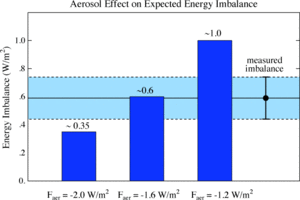用戶:Bdgzczy/沙盒/1

地球能量收支或全球能量收支預算(英語:Earth's energy budget)指的是入射大氣系統的來自太陽的能量減去散失到外層空間的能量後留在地球和地球大氣層中的能量。[2]對於地球能量收支變化的的量化測量值準確地和全球變暖相聯繫。[3]
由於赤道接收的來自太陽的能量較兩極多,入射太陽短波輻射在地球不均勻地分佈。入射能量被大氣圈和水圈吸收,通過地表水的蒸發、對流、降水、風和洋流進一步分佈。當入射的太陽輻射與散發到外層空間的能量相同時,地球屬於輻射平衡,全球氣溫相對穩定。
當例如溫室氣體增加時,地球輻射平衡被改變,全球氣溫也會改變。[4]然而,地球能量平衡和熱量的變動收許多因素影響,例如大氣層中化學各物質的佔比(主要有氣溶膠、溫室氣體的佔比)、地表物體的反照率、雲量、植被和土地利用方式。地球表面溫度的改變並不是緊隨着地球能量收支的變化而變化,由於海洋和冰雪圈對於新能量收支反應的滯後性。淨熱通量變化在入射和離開地球能量的新平衡狀態達到導致氣候變化前最主要受到了海洋熱含量的緩衝。[5]
能量收支[編輯]
入射輻射能量[編輯]
全球平均每340 W/m²的入射短波輻射有75 W/m²被雲層反射回外層空間,30 W/m²被地表反照反射,大約235 W/m²被地球吸收。[7]
地球內部熱量和其他小影響[編輯]
來自地球的地熱能量約為47兆瓦(47,000,000,000,000瓦)。[8]平均為0.087 W/m²,只佔地球表面總能量收支的0.027%,相對於主要的入射太陽輻射(約173,000兆瓦(173x1015瓦))十分微小。[9]
另外也有其他微小的能量來源會影響地球能量收支,但由於數值過於微小而通常忽略不計。例如星際物質的堆積、來自其他行星的光和太空熱輻射。雖然這些輻射經常被忽略不計,但是約瑟夫·傅里葉認為這些輻射對於地球能量收支存在一定影響,同時在他的論文中常將其引用為溫室效應的誘因之一。[10]
地球長波輻射[編輯]
地球長波輻射指的是地球到外層空間的低能量輻射紅外線。當長波輻射離開地球表面後,會先受到大氣層的吸收和雲層的反射,其餘的熱量將傳導到外層空間。
地球能量不平衡[編輯]
當入射能量和散失的熱輻射不相等時,地球能量不平衡將會產生,導致淨熱通量增加或減少。由Argo計劃提供的地球能量不平衡數據測量了近十年的累計海洋熱含量。在2005至2010年間的太陽極小期,不平衡量的估算值被測量得0.58 ± 0.15 W/m²。[11]而更新得研究估算這個數據已經增長至0.60 ± 0.17 W/m²。[12]
為了研究地球能量不平衡,一些衛星也被發射到了地球軌道用以間接測量地球吸收和散失的能量,從而推斷出地球能量不平衡,這些衛星包括來自美國太空總署的地球輻射收支實驗(英語:Radiation Budget Experiment (ERBE))的衛星。[13]
美國太空總署地球觀測系統(英語:Earth Observing System (EOS))的雲和地球輻射能量系統(英語:Clouds and Earth's Radiant Energy System (CERES))的衛星專門設計為測量大氣頂到地面的太陽反射輻射和地球放出輻射而設計。[14]
自然溫室效應[編輯]

The major atmospheric gases (oxygen and nitrogen) are transparent to incoming sunlight, and are also transparent to outgoing thermal infrared. However, water vapor, carbon dioxide, methane, and other trace gases are opaque to many wavelengths of thermal infrared energy. The Earth's surface radiates the net equivalent of 17 percent of incoming solar energy as thermal infrared. However, the amount that directly escapes to space is only about 12 percent of incoming solar energy. The remaining fraction—a net 5-6 percent of incoming solar energy—is transferred to the atmosphere when greenhouse gas molecules absorb thermal infrared energy radiated by the surface.[15]

When greenhouse gas molecules absorb thermal infrared energy, their temperature rises. Like coals from a fire that are warm but not glowing, greenhouse gases then radiate an increased amount of thermal infrared energy in all directions. Heat radiated upward continues to encounter greenhouse gas molecules; those molecules absorb the heat, their temperature rises, and the amount of heat they radiate increases. At an altitude of roughly 5–6 kilometres, the concentration of greenhouse gases in the overlying atmosphere is so small that heat can radiate freely to space.[15]
Because greenhouse gas molecules radiate infrared energy in all directions, some of it spreads downward and ultimately comes back into contact with the Earth's surface, where it is absorbed. The temperature of the surface becomes warmer than it would be if it were heated only by direct solar heating. This supplemental heating of the Earth's surface by the atmosphere is the natural greenhouse effect.[15]
氣候敏感度[編輯]
A change in the incident or radiated portion of the energy budget is referred to as a radiative forcing.
The climate sensitivity is defined as the steady state change in the equilibrium temperature as a result of changes in the energy budget.
氣候因子和全球變暖[編輯]

Changes in Earth's climate system that affect the energy which enters or leaves the system alters Earth's radiative equilibrium, and thus can force temperatures to rise or fall, are called climate forcings. Natural climate forcings include changes in the Sun's brightness, Milankovitch cycles (small variations in the shape of Earth's orbit and its axis of rotation that occur over thousands of years), and large volcanic eruptions that inject light-reflecting particles as high as the stratosphere. Man-made forcings include particle pollution (aerosols), which absorb and reflect incoming sunlight; deforestation, which changes how the surface reflects and absorbs sunlight; and the rising concentration of atmospheric carbon dioxide and other greenhouse gases, which decrease heat radiated to space.
A forcing can trigger feedbacks that intensify (positive feedback) or weaken (negative feedback) the original forcing. For example, loss of ice at the poles, which makes them less reflective, is an example of a positive feedback.[16]
The observed planetary energy imbalance during the recent solar minimum shows that solar forcing of climate, although significant, is overwhelmed by a much larger net human-made climate forcing.
Today, anthropogenic perturbations in greenhouse gas concentration are responsible for a positive radiative forcing which reduces the net longwave radiation loss out to space, hence the radiative equilibrium is disturbed. It has been suggested to reduce atmospheric CO2 content to about 350 ppm, in order to stop further global warming. The data also show that climate forcing by human-made aerosols is larger than usually assumed, hence more global aerosol monitoring would improve people's understanding of interpretation of recent climate change.[11]
參看[編輯]
- 行星平衡溫度
- 雲和地球輻射能量系統
參考資料[編輯]
- ^ 1.0 1.1 1.2 The NASA Earth's Energy Budget Poster. NASA.
- ^ IPCC AR5 WG1 Glossary 2013 "energy budget (of the earth)"
- ^ Graeme L. Stephens, Juilin Li, Martin Wild, Carol Anne Clayson, Norman Loeb, Seiji Kato, Tristan L'Ecuyer, Paul W. Stackhouse Jr, Matthew Lebsock and Timothy Andrews. An update on Earth's energy balance in light of the latest global observations (PDF). Nature Geoscience. September 23, 2012. Bibcode:2012NatGe...5..691S. doi:10.1038/NGEO1580.
- ^ Lindsey, Rebecca. Climate and Earth's Energy Budget. NASA Earth Observatory. 2009.
- ^ M, Previdi; et al. Climate sensitivity in the Anthropocene. Royal Meteorological Society. 2013. Bibcode:2013QJRMS.139.1121P. doi:10.1002/qj.2165.
- ^ Wild, Martin; Folini, Doris; Schär, Christoph; Loeb, Norman; Dutton, Ellsworth; König-Langlo, Gert. The Earth's radiation balance and its representation in CMIP5 models. Copernicus. 2013. Bibcode:2013EGUGA..15.1286W.
- ^ Kevin E. Trenberth, John T. Fasullo, Jeffrey Kiehl. 周躍武,白虎志 譯. 全球能量收支预算 (PDF). 乾旱氣象. 2010, (2010年6月第28卷第2期).
- ^ Davies, J. H., & Davies, D. R. (2010).
- ^ Archer, D. Global Warming: Understanding the Forecast. 2012. ISBN 978-0-470-94341-0.
- ^ Connolley, William M. William M. Connolley's page about Fourier 1827: MEMOIRE sur les temperatures du globe terrestre et des espaces planetaires. William M. Connolley. 18 May 2003 [5 July 2010].
- ^ 11.0 11.1 11.2 James Hansen, Makiko Sato, Pushker Kharecha and Karina von Schuckmann. Earth's Energy Imbalance. NASA. January 2012.
- ^ http://www.nature.com/ngeo/journal/v5/n10/full/ngeo1580.html
- ^ Effect of the Sun's Energy on the Ocean and Atmosphere (1997)
- ^ B.A. Wielicki; et al. Mission to Planet Earth: Role of Clouds and Radiation in Climate. Bull. Amer. Meteorol. Soc. 1996, 77 (5): 853–868. Bibcode:1996BAMS...77..853W. doi:10.1175/1520-0477(1996)077<0853:CATERE>2.0.CO;2.
- ^ 15.0 15.1 15.2 Edited quote from public-domain source: Lindsey, R., The Atmosphere's Energy Budget (page 6), in: Climate and Earth's Energy Budget: Feature Articles, Earth Observatory, part of the EOS Project Science Office, located at NASA Goddard Space Flight Center, January 14, 2009
- ^ 16.0 16.1 NASA: Climate Forcings and Global Warming. January 14, 2009.
